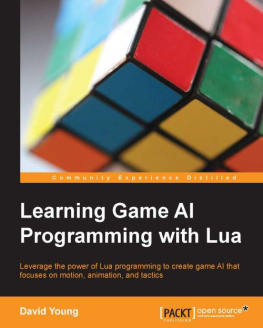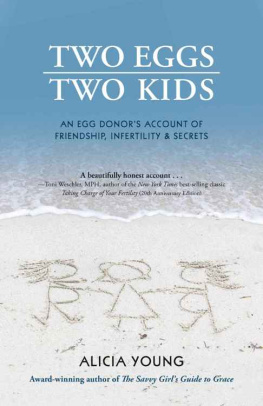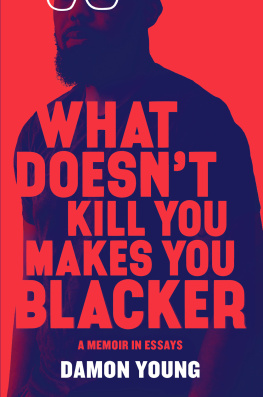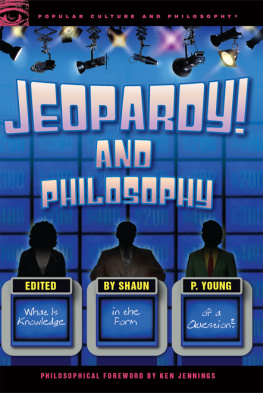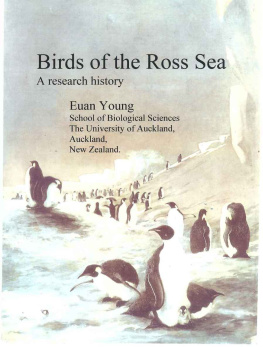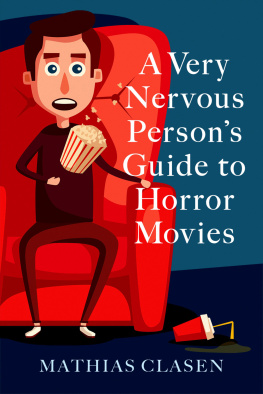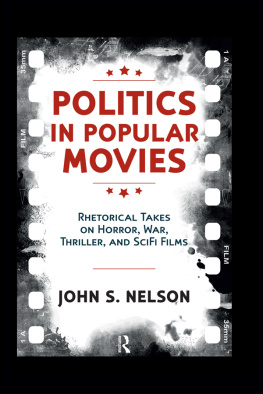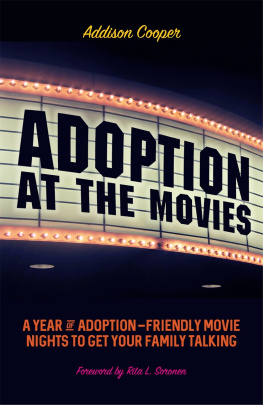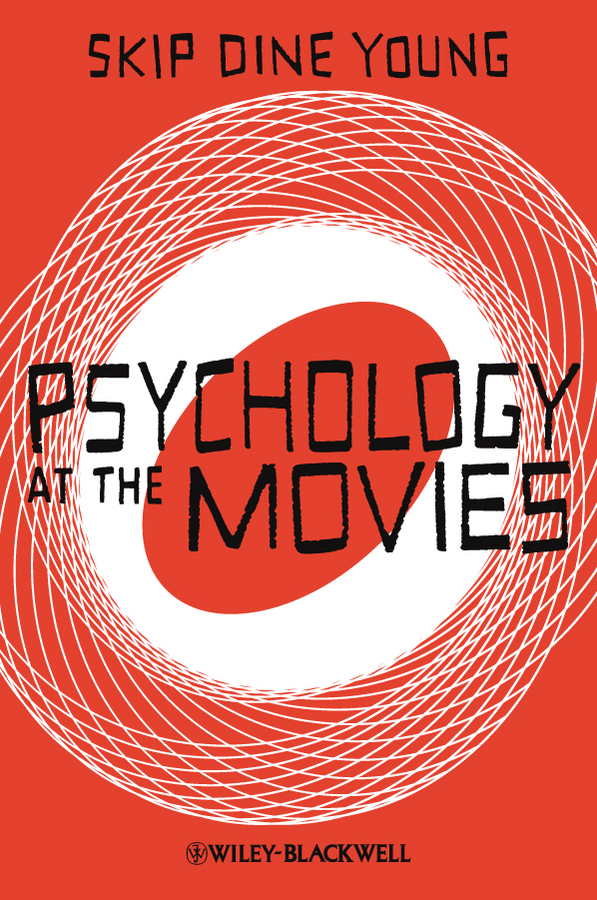
Psychology at the Movies
Skip Dine Young
Professor of Psychology, Hanover College, Indiana, USA
This edition first published 2012
2012 Skip Dine Young
Wiley-Blackwell is an imprint of John Wiley & Sons, formed by the merger of Wiley's global Scientific, Technical and Medical business with Blackwell Publishing.
Registered Office
John Wiley & Sons Ltd, The Atrium, Southern Gate, Chichester, West Sussex, PO19 8SQ, UK
Editorial Offices
350 Main Street, Malden, MA 02148-5020, USA
9600 Garsington Road, Oxford, OX4 2DQ, UK
The Atrium, Southern Gate, Chichester, West Sussex, PO19 8SQ, UK
For details of our global editorial offices, for customer services, and for information about how to apply for permission to reuse the copyright material in this book please see our website at www.wiley.com/wiley-blackwell.
The right of Skip Dine Young to be identified as the author of this work has been asserted in accordance with the UK Copyright, Designs and Patents Act 1988.
All rights reserved. No part of this publication may be reproduced, stored in a retrieval system, or transmitted, in any form or by any means, electronic, mechanical, photocopying, recording or otherwise, except as permitted by the UK Copyright, Designs and Patents Act 1988, without the prior permission of the publisher.
Wiley also publishes its books in a variety of electronic formats. Some content that appears in print may not be available in electronic books.
Designations used by companies to distinguish their products are often claimed as trademarks. All brand names and product names used in this book are trade names, service marks, trademarks or registered trademarks of their respective owners. The publisher is not associated with any product or vendor mentioned in this book. This publication is designed to provide accurate and authoritative information in regard to the subject matter covered. It is sold on the understanding that the publisher is not engaged in rendering professional services. If professional advice or other expert assistance is required, the services of a competent professional should be sought.
Library of Congress Cataloging-in-Publication Data
Young, Skip Dine.
Psychology at the movies / Skip Dine Young.
p. cm.
Includes bibliographical references and index.
ISBN 978-0-470-97177-2 (pbk.)
1. Motion picturesPsychological aspects. 2. Psychoanalysis and motion pictures.
3. Motion picture audiencesPsychology. 4. Psychiatry in motion pictures.
5. Psychoanalysis in motion pictures. 6. Mental health personnel in motion pictures.
I. Title.
PN1995.Y63 2012
791.436561dc23
2011042656
A catalogue record for this book is available from the British Library.
Wiley also publishes its books in a variety of electronic formats. Some content that appears in print may not be available in electronic books.
To My Family
List of Illustrations and Figures
Illustrations
Robert De Niro as Travis Bickle in Taxi Driver (1976) AF archive/Alamy
Director Martin Scorsese holds a gun on the set of Taxi Driver Steve Schapiro/Corbis
John Hinckley Jr, who attempted to assassinate Ronald Reagan in 1981, poses in front of the White House. Bettmann/Corbis
Ray Bolger, Jack Haley, Judy Garland & Bert Lahr in The Wizard of Oz (1939) Pictorial Press Ltd/Alamy
Anthony Perkins as Norman Bates in Psycho (1960) AF archive/Alamy
Robin Williams & Matt Damon as Sean & Will in Good Will Hunting (1997) Moviestore Collection Ltd/Alamy
Woody Allen and Mia Farrow in New York City. March 1986. Trinity Mirror/Mirrorpix/Alamy
Mia Farrow & Woody Allen as Judy & Gabe in Husbands and Wives (1992) AF archive/Alamy
Natalie Portman as Nina Sayers in Black Swan (2010) Pictorial Press Ltd/Alamy
Jim Carrey & Kate Winslet as Joel Barish & Clementine Kruczynski in Eternal Sunshine of the Spotless Mind (2004) AF archive/Alamy
Linda Blair & Max von Sydow as Regan & Father Merrin in The Exorcist (1973) Moviestore Collection Ltd/Alamy
Juliette Lewis & Woody Harrelson as Mallory & Mickey in Natural Born Killers (1994) AF archive/Alamy
A still from a security video shows Dylan Klebold & Eric Harris on the day they killed twelve students and one teacher at Columbine High School, Colorado. April 20, 1999. Reuters/Corbis
Al Pacino as Sonny in Dog Day Afternoon (1975) Photos 12/Alamy
Mark Hamill, Carrie Fisher & Harrison Ford as Luke, Leia & Han in Star Wars: Episode IV - A New Hope (1977) Pictorial Press Ltd/Alamy
Alec Guinness & George Lucas on the set of Star Wars: Episode IV - A New Hope (1977) AF Archive/Alamy
Skip Young, Star Wars fan, age 10
Figures
Symbolic activity in film
The many faces of Psychology at the Movies
Symbolic activity in film viewing: Comprehension, emotion and perception
Symbolic activity in film viewing: Interpretation and evaluation
Symbolic activity in film viewing: Function and effect
Symbolic activity in film (expanded)
Acknowledgments
I would especially like to thank Lindsay Marsh and Mary Ryan. Without their help I would never have been able to finish this book (at least not in the current decade). As my research assistant, Lindsays patience and attention to detail allowed me to focus and work around my own limitations. Marys invaluable editing and commentary made the manuscript infinitely more readable and helped me (begin) to unlearn decades of bad writing habits.
I appreciate the feedback I received on drafts of the manuscript from my colleagues Bill Altermatt, John Krantz, Ellen Altermatt, Mark Fearnow, Bill Bettler, Jared Bates and Ron Smith. Their comments helped me make adjustments and gave me perspective when I needed it. I am lucky to be a part of a vital faculty that is a tribute to the liberal arts.
Hanover College has been a great support to this project. The grant I received from the Faculty Development Committee and the sabbatical leave from the Board of Trustees provided me with the funding and time I needed. In addition the staff at Duggan Library (especially Patricia Lawrence, Mary Royalty, Ken Gibson and Lela Bradshaw) were extremely accommodating in my attempts to acquire the materials I needed for my own little psychology and film library. I would also like to thank whoever made the decision for the College to mow the lawns on campus housing. That was one distraction I didnt have to worry about that might otherwise have pushed me over the edge.
I am grateful to the many students I have worked with, particularly those who have taken The Psychology of Film over the past 15 years. I have found that having students is the only way professors can figure out what is really important.
I thank the faculty at Clark University, particularly my mentors Bernie Kaplan and Lenny Cirillo. Most of the ideas in this book first came to me in graduate school, and I am eternally grateful for the unique intellectual environment at Clark that nurtured so many different thoughts and convinced me that psychoanalytic interpretations of movies and psychological experiments belong in the same universe.
The publication team at Wiley-Blackwell (Andy Peart, Karen Shield and Tori Halliday) gently guided me through a process that was new to me. I appreciate the opportunity.
Next page

